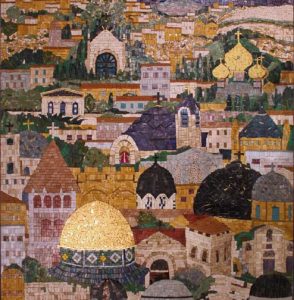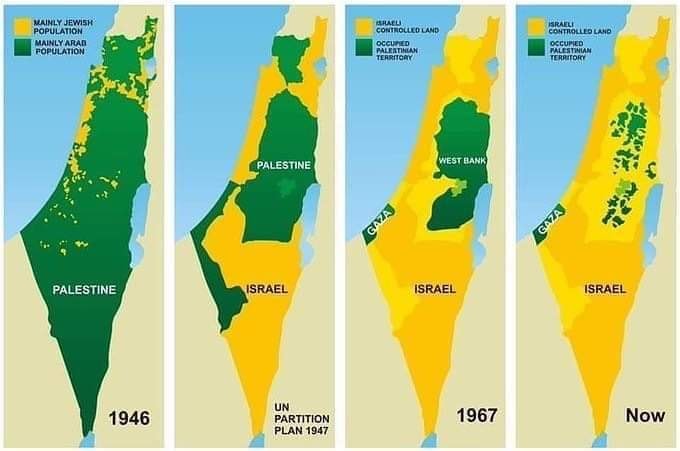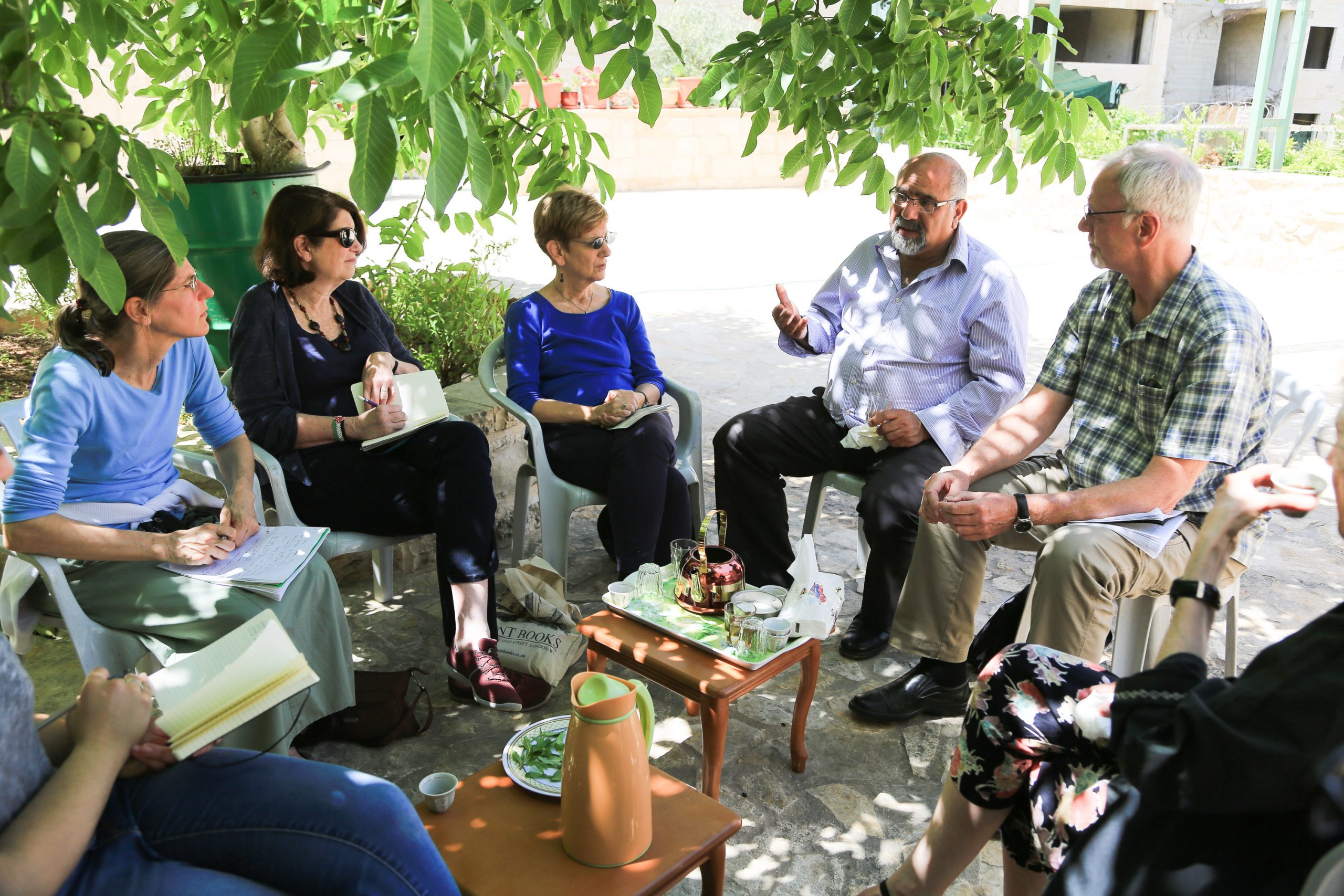The Holy Land Today
An important first step in planning to visit the Holy Land is realizing its contemporary realities. Like any travel destination, the Holy Land was not frozen in time. Its history, both ancient and modern, gave rise to the place it is today, the place we encounter when we visit. By combining our experiences of the ancient – the sites of Jesus’ life and ministry – with the modern, we enrich our understanding and achieve the transformation of true pilgrimage.
The region known as the Holy Land is now comprised of distinct political entities: the Occupied Palestinian Territories and the state of Israel. Geographically, the area is quite small, roughly the size of Massachusetts, and resembles a long narrow triangle. Its small size makes it easy for the visitor to get around and see all the traditional holy sites that most visitors want to see.

Like hundreds of thousands others, these Palestinians flee the violence of 1948 on foot, taking only what they can carry.
The recent history of this area has been eventful. The state of Israel was established in 1948 in the area known then as Mandate Palestine. Contrary to some commonly held beliefs, the land was not empty then. It was inhabited by indigenous people as it had been for centuries. They were mostly Palestinians, Muslim and Christian, living alongside a handful of indigenous Jewish people.
In the 1940s, things really began to change. Driven by the urge of Zionism and to escape the rise of fascism in Europe, Jewish immigration had increased in the decades between World War I and II. Zionists were seeking a state of their own, a “Jewish state”. As the urge became stronger, it became militant. Armed groups were formed and initiated armed conflict to establish the new state. The native Palestinians resisted but Zionism prevailed, the new state was declared, and hundreds of thousands of native Palestinians were displaced and became refugees.
Then, in 1967 the Six Day War resulted in Israeli military occupation of Jerusalem, the West Bank and Gaza Strip that continues to the present day. And this is the reality that we encounter when we visit today: Palestinians living in the West Bank and Gaza under occupation have no rights and are subject to Israeli military control of all aspects of life. These circumstances are eerily reminiscent of the time of Jesus, when Roman occupation created the setting for Jesus’ ministry of justice, hospitality, tolerance, and mercy. This unfortunate contemporary situation gives today’s visitor the unique chance to experience the Holy Land much as Jesus knew it. It is an opportunity for a true pilgrimage.
The maps below illustrate the momentous changes that have occurred in control of the lands available for living to Israelis and Palestinians. The inequality is obvious; one can imagine the ways that life has changed for Palestinians. For people who follow Jesus, visiting the places and the people who have lived these changes opens the way to new understandings about justice, forgiveness, hospitality, and compassion. We urge you to Go and See!
As you consider both the ancient and modern histories of this remarkable place, how can you best experience the vital, living witness of Jesus’ presence, as well as enjoy those special historical sites? Several ways are summarized below. Additional information about travel companies and the resources mentioned here can be found in the Resources section of this page.
- Walk in Jesus’ Footsteps. Naturally, this is the very first thing that pilgrims want to do, to experience the Holy Land as close to the way it was for Jesus as is possible in the 21st century. With the similarities of today’s Holy Land to Jesus’ own time, it is important to trace the steps that he might have taken in the course of his ministry. Surely, we can imagine he was with people in need, people who were ill or suffering oppression of the day. You can retrace Jesus’ ministry by visiting a refugee camp, for example. Each camp has visitor centers where you are welcome to meet the residents and hear their stories. There are three camps in Bethlehem: Aida, Dheisheh, and Beit Jibrin. In the West Bank, learn what life is like under occupation and military control, just as it was for Jesus. Arrange a half-day tour in the ancient city of Hebron and learn about Jewish settlements. The Diocese of Jerusalem has churches and hospitals in Ramallah, Nablus, and Zebabdeh in the West Bank where you will be enthusiastically and graciously welcomed to learn about their work and ministries. Very comfortable accommodations are available in Ramallah and Nablus. Zebabdeh is an easy day trip from either city.
- Meet and Get To Know Palestinians. Strange to say but many visitors to the Holy Land never have the opportunity to meet and know the indigenous Palestinian people. Their presence is often overlooked by tour leaders who emphasize only the well-known sites and their histories and not the people of today. As a matter of fact, the Christians of today’s Holy Land are Palestinian and they are delighted to welcome modern pilgrims. In Jerusalem, be sure to shop, eat, and stroll along Salah a-Deen Street, Nablus Road and the neighborhoods of east Jerusalem where most Jerusalem Palestinians live. Visit the Muslim and Christian Quarters of the Old City. Take the time to talk to people and listen to their histories and stories. Visit the West Bank where Bethlehem, Bethany, Jericho, Jacob’s Well and other holy sites are located. Stay a few extra days in Bethlehem to attend a church service and learn about the lives of modern Christians in the Holy Land.
Many people miss the rich opportunities available in Holy Land travel out of concern about safety and security. News headlines too often depict a place of danger inhabited by violence-prone people. This is inaccurate and misleading and unfortunately deprives many of life-altering experiences.
The fact is that traveling in the region is remarkably safe. Tourism is a major industry of Israel and a major source of revenue. A record 4.5 million tourists visited in 2019, bringing $6.3 billion dollars to the economy. Israel is careful to ensure that this continues, so safety is a top priority.
What about going into the West Bank? It is perfectly legal for US visitors to enter the West Bank with their passport and Israeli tourist visa that is issued on your arrival in the country. Inexpensive public and private transportation is available from Jerusalem. In visits to the West Bank you may encounter checkpoints operated by Israeli security personnel. These encounters are perfectly safe and give the traveler a unique opportunity to witness and experience the way of life for Palestinians.
Members of EPF PIN cumulatively have made hundreds of visits to the Holy Land over the years, and some have even lived there for periods of time with no incidents of danger or injury. In fact, Jerusalem and even the West Bank are safer than many American cities.
EPF PIN urges you to experience the entire richness of Holy Land travel by not missing this vital and important part of it.
Rick Steves, one of the world’s best known travelers, made an extended visit to Israel and Palestine, traveling throughout the West Bank. He delighted in his experiences there and in fact has become an enthusiastic supporter of a Palestinian non-profit organization. (
https://blog.ricksteves.com/blog/category/palestine/ )
Read of the many pilgrimages of The Rt. Rev. Greg Rickel, 8th Bishop of Olympia here (
https://bishoprickel.wordpress.com/2020/01/25/holy-land-pilgrimage-2020-day-1-and-2/“My advice is don’t go to Israel and be content with the conventional tours and perspectives that only give you the Israeli point of view. Decide for yourself and tour the Holy Land with an open mind. “ – Traveler with Green Olive Tours
“As I returned to the US and listened to friends and family stress about the “danger” of life in Israel, I had to hold back my chuckle. I never once felt endangered or scared. I was too busy soaking up the depth and width of God’s love for the world and for me. There was nothing to fear, nothing to fret, nothing to worry about. “ – Rev. Adam Trambley





